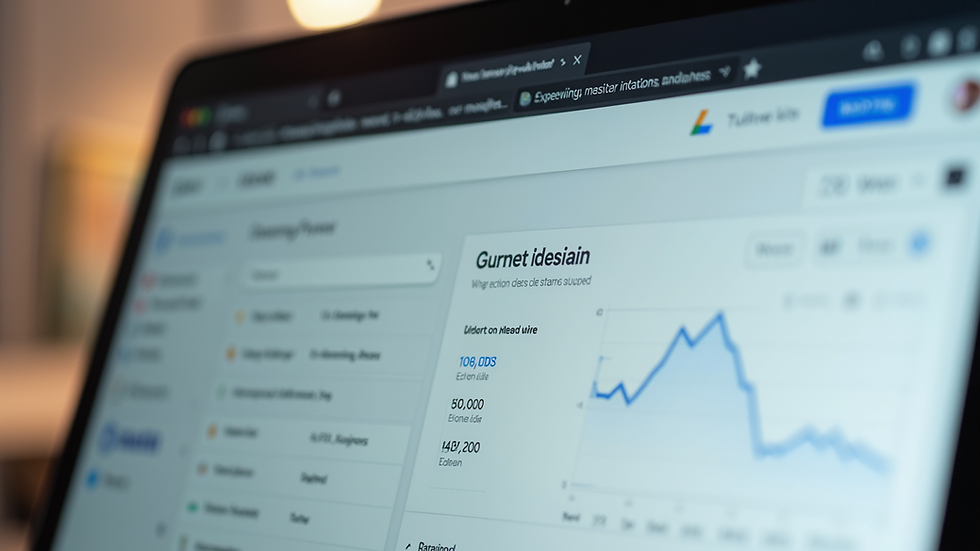Take Your Google Ads to the Next Level with These 5 Key Tools
- Haroon Qureshi
- Apr 9
- 4 min read
Navigating the complex world of Google Ads can be challenging for even the most seasoned professionals.
Whether you're managing multiple accounts for various clients or running in-house campaigns, optimizing your Google Ads is crucial for driving better ROI and saving time.
Let's explore the essential tools every Google Ads advertiser should be using and explain how each one can help elevate your campaign performance.
1. Google Keyword Planner
One of the foundational tools available in your Google Ads arsenal is the Google Keyword Planner. This tool is invaluable for discovering high-intent keywords that align perfectly with your marketing goals.
First and foremost, it allows you to estimate search volume, cost-per-click (CPC), and competition for various keywords. By analyzing this data, you can identify the most relevant keywords to target, which is essential for building effective ad groups.
Additionally, the Google Keyword Planner is a fantastic resource for planning budget allocation. For instance, if you're eyeing a keyword with high search volume but also high CPC, it’s crucial to adjust your bidding strategy accordingly. A well-informed decision here can set the stage for a more successful campaign.

2. Google Ads Editor
If scalability is a concern for you, Google Ads Editor is a must-have tool. This downloadable application empowers advertisers to manage campaigns efficiently, especially when dealing with large accounts or complex structures.
With Google Ads Editor, you can make bulk edits in a matter of minutes. For example, suppose you’re running seasonal promotions and need to adjust bids or ad copies across multiple campaigns. This tool allows you to implement changes offline and then sync them once you’re connected again. This feature can save you countless hours, making it easier to focus on strategy rather than tedious edits.
Moreover, the ability to conduct bulk operations helps maintain a cleaner, more organized account structure, allowing you to respond quickly to performance metrics and market shifts.

3. Google Analytics (preferably GA4)
Understanding the full picture of your ad performance requires insights beyond just clicks and impressions. That’s where Google Analytics, especially the latest GA4, comes into play. This tool provides invaluable insights into post-click behavior and the conversion paths users take after interacting with your ads.
With GA4, you can drill down to identify which pages or audiences are driving the most performance. For example, if certain landing pages are converting well, you might want to invest more in advertising these specific funnels or services.
Most importantly, integrating GA4 with Google Ads helps optimize your bidding and targeting strategies. By analyzing user behavior post-click, you can determine which audiences are more likely to convert, allowing your campaigns to be more targeted and effective.

4. Google Tag Manager
Managing your tracking tags can often feel like a daunting task, particularly when multiple tags are involved. Google Tag Manager (GTM) serves as a central hub for managing all tracking tags without the need to edit your site’s code.
GTM simplifies the deployment of crucial tools like conversion tracking, remarketing tags, and event-based goals. This tool increases your agility and reduces your reliance on developer input, allowing your marketing team to adapt quickly to changing campaigns.
For instance, if you want to set up a new remarketing campaign, using GTM lets you quickly deploy the necessary tags without waiting on a developer's schedule. This level of control can lead to faster decision-making and improved performance outcomes.
5. Google Ads Scripts
For those who thrive on automation, Google Ads Scripts are an incredible asset. Scripts allow you to automate repetitive tasks like bid adjustments, pausing low-performing ads, or generating reporting insights. This not only increases efficiency but also helps maintain a cleaner account.
Imagine creating a script that automatically adjusts bids based on performance metrics such as click-through rate or conversion rates. Custom workflows can help in tailoring responses to different market conditions without needing to monitor everything manually.
By automating such tasks, you can focus on strategic planning and optimization rather than day-to-day management tasks, leading to improved overall performance.
Maximizing Your Google Ads Toolkit
Utilizing these tools can significantly leverage your Google Ads campaigns. From the foundational keyword insights provided by Google Keyword Planner to the automation capabilities of Google Ads Scripts, each tool is a stepping stone to greater efficiency and effectiveness.
Start by integrating one tool at a time into your workflow. This method will allow you to fully grasp each tool's capabilities before moving onto the next one. As you become more comfortable, you’ll find that your campaigns will not only run more smoothly but also yield better results.
In summary, exploring these five tools can help you streamline campaign management while improving your overall performance. Each one is designed to help you make data-backed decisions that can lead to smarter, faster advertising.
Don't wait another day to enhance your Google Ads strategy. Begin exploring these tools and watch your campaigns transform!




Comments